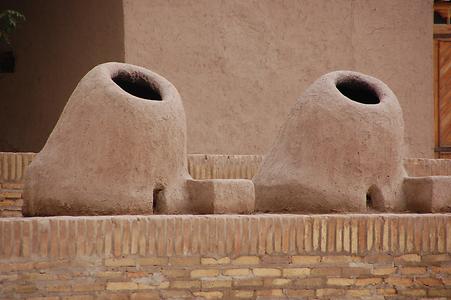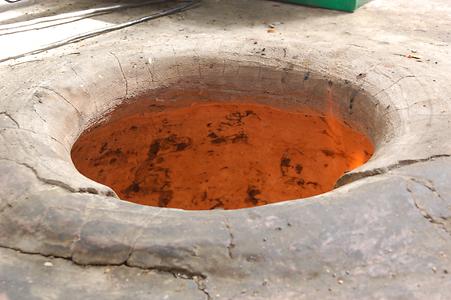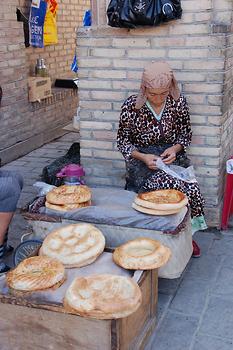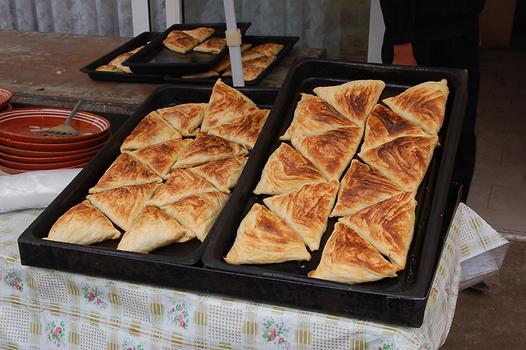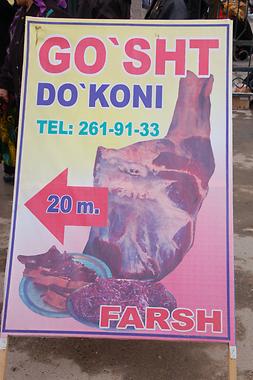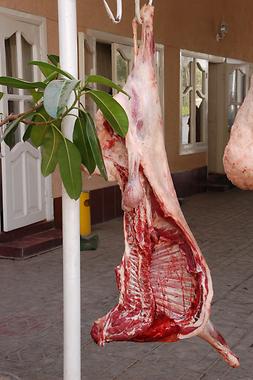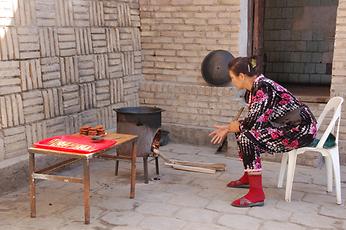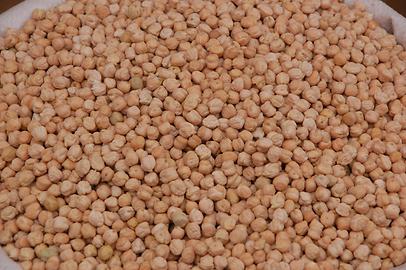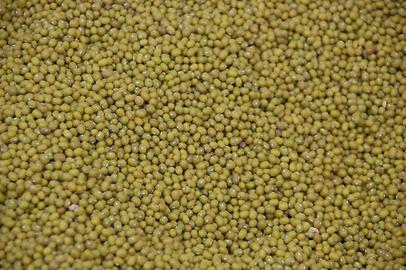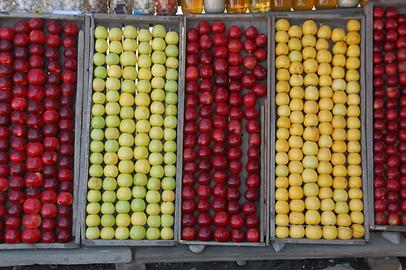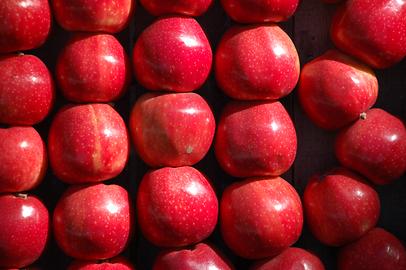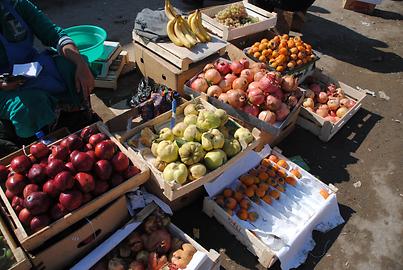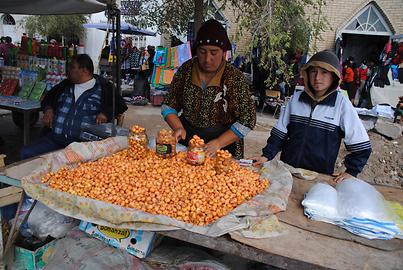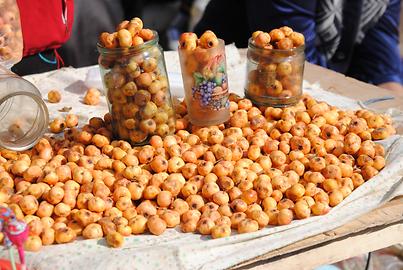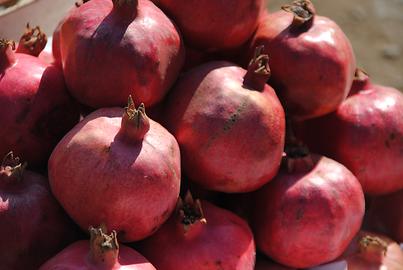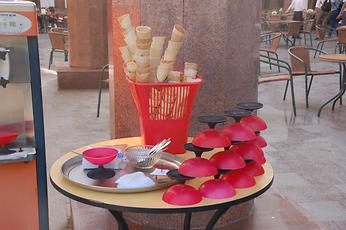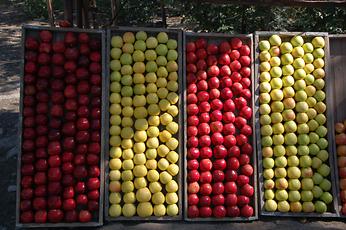Food in Uzbekistan#
A country rich in specialities#
byAll pictures were taken by the author in the years 1985, 2011 and 2012. They are part of the archive "Picture-flood Jontes".

Uzbekistan Usbekistan has a special role among the Central Asian successor states of the Soviet Union. Its most important cities were stations of the Silk Road which brought cultural influences from both East and West, among which the food culture plays an important part. In a menu – since the political turn Latin script replaced Cyrillic script – there are terms such as kabof, plof or shashlik. The counterparts in Turkish or Arabic are kebap, pilaf and so on. Uzbek cuisine is regarded as one of the tasty and varied among halal cuisines.
The Uzbek Emirates were already included in the Russian Empire at the time of 1868. After the end of the monarchy, Uzbekistan was almost seamlessly incorporated into the Communist Soviet Union in 1918. After the end of the Soviet Union, the Central Asian republics succeeded in liberating themselves and gaining sovereignty. Apart from Tajikistan, where an Iranian-Indo-European language is spoken, Turkic languages prevail in all other states from Turkmenistan to Kazakhstan, a political advantage for Turkey.
The historical roots of Uzbekistan lie in the sphere of culture of ancient Persia with its religion going back to Zarathustra, worshiping fire. Later on, violent Islamization brought about a completely new form of life which also led to fundamental changes in the food sector.
In Islam, food and dishes are cooked and eaten only if they correspond to the dietary requirements defined by the Koran and Hadith. They must be halal. This Arabic word means "allowed, permissible". Its opposite is haram "prohibited". In between, there is the word makruh, meaning "not expressly forbidden, but undesirable". This offers a wide field of controversy of Muslim imams and muftis.
The author of the Koran has borrowed from the Mosaic dietary rules which were quite reasonable at that time. The consumption of pork and its by-products as well as blood is forbidden. In addition, the permitted meat must come from animals which have been slaughtered in a ritual manner. This means that the throat of the animal must be cut with one incision without anesthesia. Alcohol is reserved for the blessed in paradise, a commandment which in many cases is not followed in Islamic countries.
In addition to rice, the basic food is flatbread which is baked in the clay oven Tandyr . Clay ovens stand in front of each house. The baking of the doughs, made from wheat flour, requires the skill and experience of the housewife, who must stick the cake to the glowing hot wall without getting burned. Since the cooking is carried out very quickly, the removal of the flatbread is not without danger.
The fresh, still oven-warm bread is offered by women in small kiosks on the street.
The bread is not only a simple round flat cake, but is decorated nicly with a special bread stamps. It has been recognized that bread stamps are nice souvenirs in a flourishing tourism country.




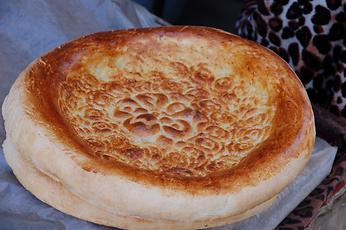
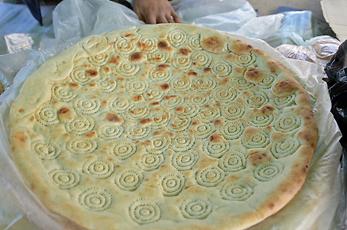

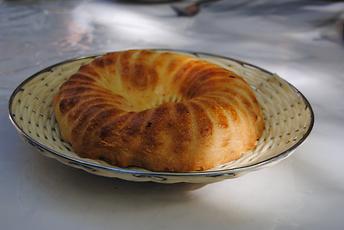
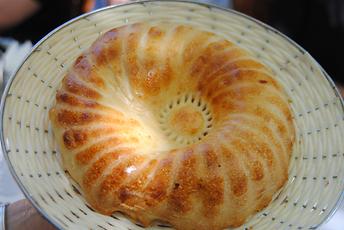
The flourishing tourism offers the strangers from the West a variety of dishes in carefully managed restaurants. The advertisement for the local cuisine is made with stimulating shop signs. Except for the „imported“ hot dog, there are dishes which are known from Bosnia to India and Indonesia but are often called slightly differently. When words are missing, images fulfill the same purpose.

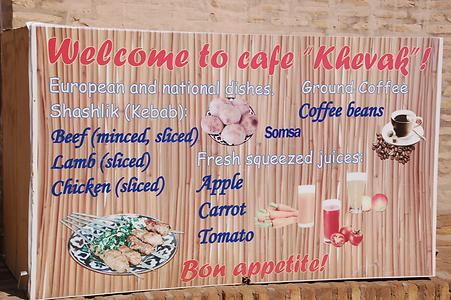
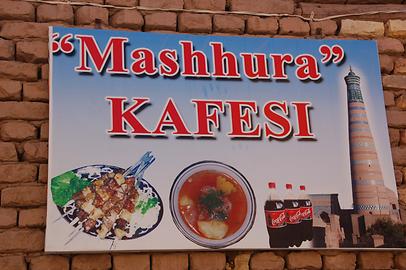
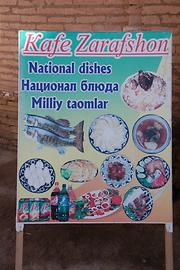
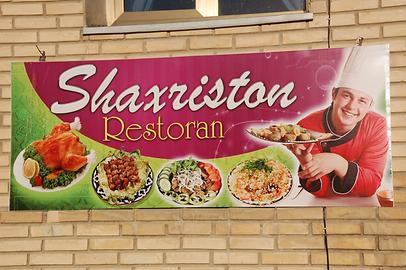
On one of the billboards the word Plow, the Islamic Pilaw, is written which is considered a national dish in Uzbekistan. It is a rice dish with lamb, onion, carrots, garlic, raisins and chillies. Manti are pastries filled with mince meat.
Somsa is a pastry, filled with meat, potatoes, onions, etc. The word comes from the Arabic sambusak. In India it is called Samosa and is a popular dish. However, Akroshka/Okroshka is a Russian heritage that has survived. It is a cold soup of sour cream with sausage, poptatoes, cucumbers, eggs and dill. Kabob is familiar to everybody in Europe, who occasionally eats a Turkish Kebab (in German Döner).




The only meat in halal-cuisine is cattle, mutton, lamb and poultry. The animals must be ritually slaughtered. For this images are used as advertisment on the markets.
Kebab turns into Shishkebab, when it is barbecued on a spit above a flame. Here the Bosnian cevapcici have their linguistic roots. The name Shashlik is widely used.

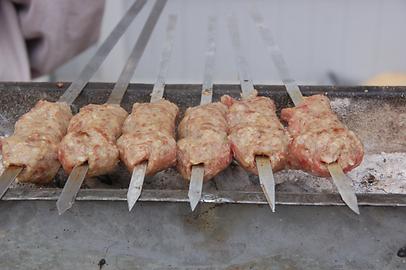
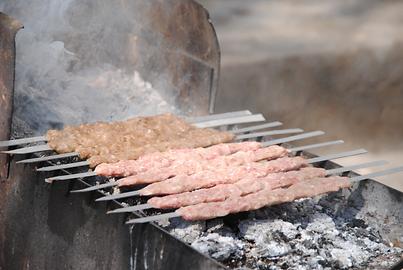
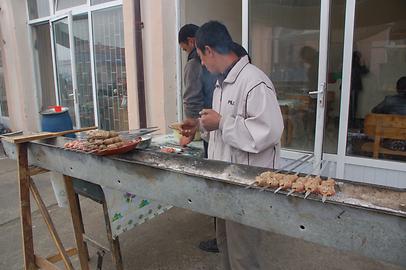
Der professionelle Kebab-Mann weiß ganz genau, wann er seinen Shashlik mundgerecht und gar servieren kann. Das Ergebnis isst man voller Genuss im Stehen oder im Vorübergehen
The professional kebap man knows exactly when he can serve his Shashlik, bite-sized and well-cooked. The result is eaten with full enjoyment while standing or passing by.
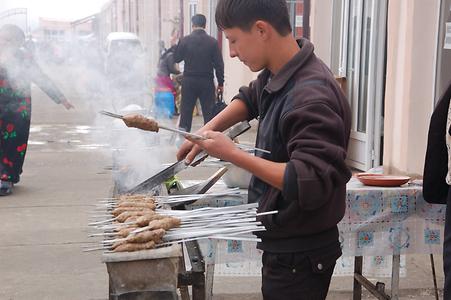
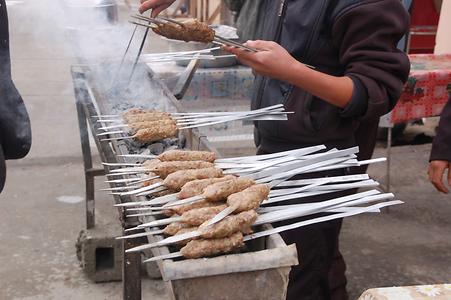
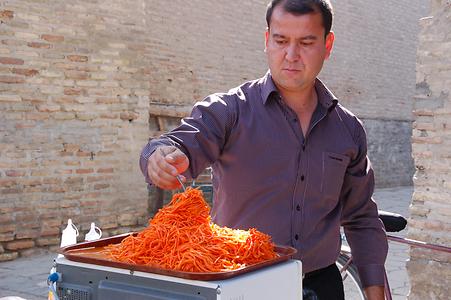

A festively laid table offers already a lot of cold starters. That the food is shown in a colorful way is essential.
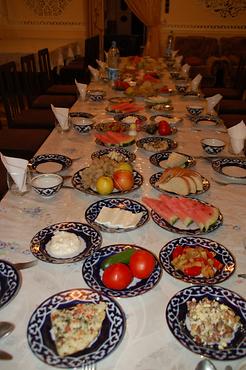
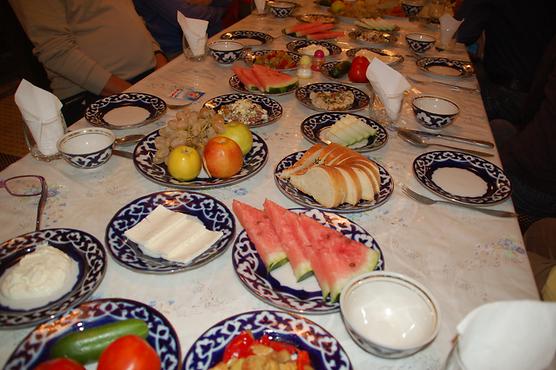
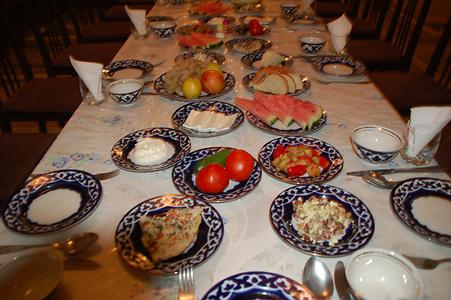

This can foloow very strict rules, but many a housemother earns a few som and offers fresh Uzbek „Fastfood“ at the front door.
The seat beds wich are above the ground serve the Uzbeks as a quiet place to dine in the „Turkish seat “ or to drink tea. In India, this furniture is called Charpoi, „four piles“. It protects people against pests on the dirty ground.

Was man im Hausgärtchen anbaut, kann auch ein wenig Überschuss ergeben und wird auf dem Markt gartenfrisch verkauft. Die usbekische Küche ist sehr gemüsereich.
What is cultivated in the small house garden can be too much to be used by the family and can provide a little extra income when sold as garden fresh vegetabel on the market.
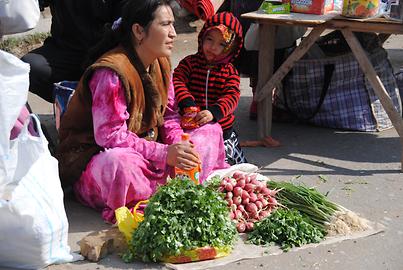
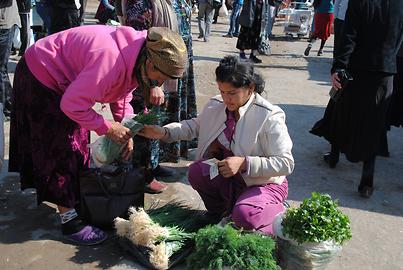

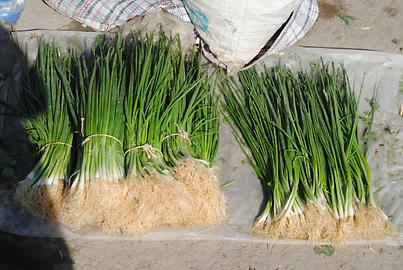
Among the peas and beans, chickpeas are particularly important.
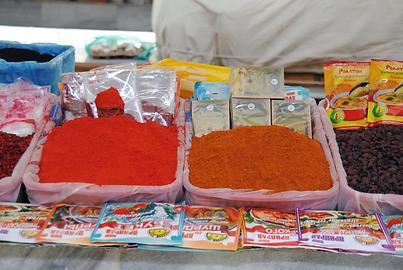
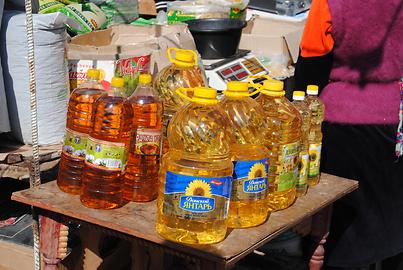
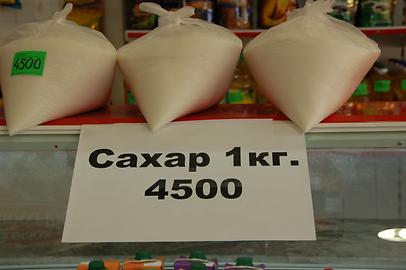

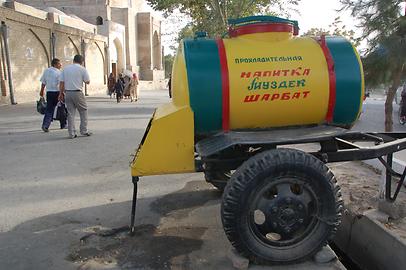

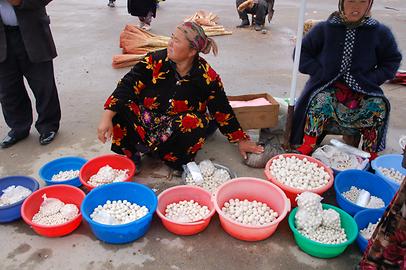
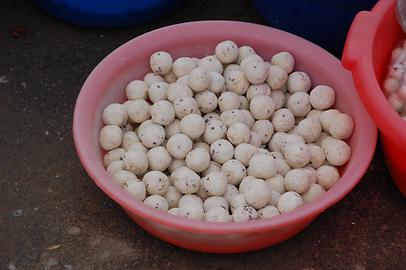


In autumn which coincides quite well with the European autumn, it becomes obvious that the country is also a fruit country. Perfect apples are offered on many streets.
Uzbekistan is also close to the original home of the grapevine. In the ancient world, the grapewine slowly and steadily reached the Mediterranean region. Ultimately, this led to the world-wide wine culture.
There are also sloes in large quantities.
Quinces and pomegranates are also very popular.
Central Asia is also famous for its dry fruits which can find their way as far as Europe.




A special establishment is the tea house, the Choyhana. There you can relax, meet with friends, drink green tea and take care of your time that you seem to have in abundance. Today, strangers also know to enjoy this offer of recreation and refreshment. Here you can easily get in touch with the locals. They move a little to the side and turn to you. They can test their language skills and even if they don’t speak a foreign language, smiles on their faces and gestures replace words. Usually it is English which they learn with zeal. They don’t like Russian language because of the past. German is spoken by people who received an education in the so-called GDR before the turnaround by the grace of Moscow. Conclusion: A teahouse is more than a restaurant. The visitor from the West should sit down, be it only for a quiet lunch time in the shade. By the way, hot green tea cools better than cold beer when the sun burns down.

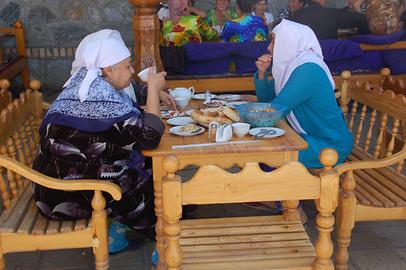

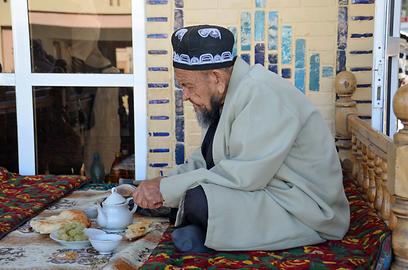
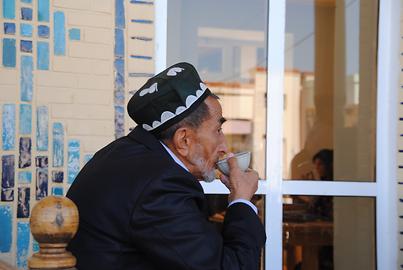
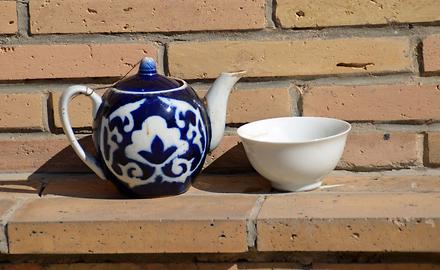


Freedom and globalization represent a threat to the old culinary traditions. Everything is open to everyone. Due to the aggressive advertising and the awakened curiosity, needs are created which did not exist before. Today, this problem exists mainly in the city, but soon smaller places will be also affected by it.
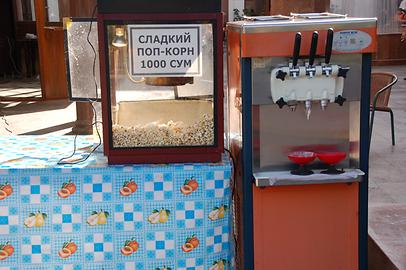
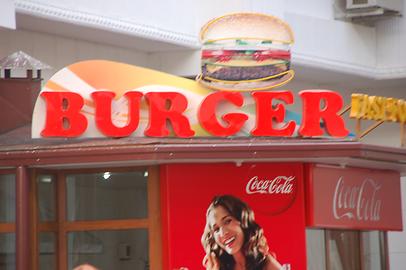
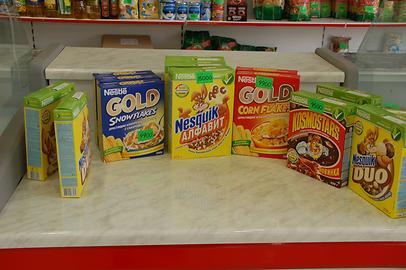

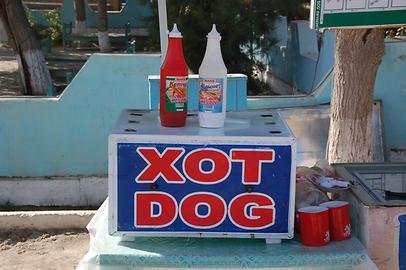
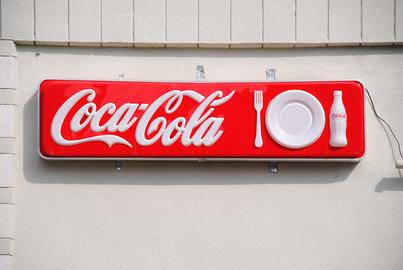


Ideologized foodstuffs such as vegetarian cuisine or sectarian veganism are not only offered to strangers, but also to the locals. This development has a negative effect on well-balanced traditional nutrition
In a restaurant frequented by strangers, an arrow, pointing upwards to the first floor with the Russian inscription "Piwo sdjes" ("beer there" )shows that beer is only offered here. Believers are not allowed to drink alcohol. Today, Uzbekistan brews a rich beer, but is under strong competition with Heineken and Tuborg.
In the Soviet Union from Moscow to Vladivastok, there was only one single species of a very good ice cream. Today, Italian ice cream is the best one.
By the way: If a muslim dreams of picking an apple, it means that he will be lucky and find a rich reward.
